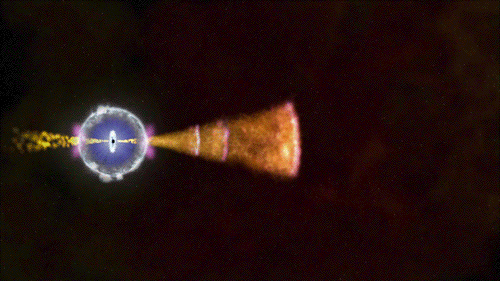Gamma-ray Bursts
Gamma-ray bursts (or GRBs) are very short and intense bursts of gamma-ray radiation. If we take a look at the electromagnetic spectrum, we can see that gamma rays are even higher in energy than X-rays. This makes the events which create them, extremely high-energy events.
GRBs were first discovered in 1967 by the Vela satellites. These satellites were not designed to search for high energy events in space. They were designed to detect Soviet nuclear missile tests which breached the nuclear test ban treaty. Their gamma radiation detectors - meant to detect radiation from nuclear missile - instead picked up gamma-ray bursts coming from outside our Solar System!
The most distant GRB discovered so far was detected by the Very Large Telescope. This GRB had a redshift of 8.2. This means the light from this GRB travelled for 13,000 million years before reaching Earth. Astronomers think this single GRB released more than 300 times the amount of energy that the Sun will emit in its entire lifetime. This shows just how high in energy these events can be.

Credit: NASA's Goddard Space Flight Center
The two types of Gamma-ray Bursts
Not all GRBs are the same. GRBs can last for different amounts of time, ranging from thousandths of a second to minutes. The amount of energy they emit also varies. A key focus of current GRB research is to investigate what creates the different types of GRBs.
Short gamma-ray bursts
GRBs which last for less than 2 seconds are short gamma-ray bursts. The mean average duration of short GRBs is 0.2 seconds. This type of GRB makes up about 30 % of the total number observed. They have been linked to high-energy collision events. For example mergers between black holes or neutron stars. These type of objects have very strong magnetic fields. The fields eject the GRBs as jets from the object's magnetic field poles.
Long gamma-ray bursts
GRBs which last for more than 2 seconds are long gamma-ray bursts. This type of GRB makes up about 70 % of the total number observed. We have been able to investigate this kind of GRB in more detail than short GRBs. This is because they last longer, there are more of them, and they have brighter 'afterglows'. This type of GRBs has been linked to the deaths of massive stars in galaxies where stars form very rapidly.

Credit: Kouveliotou C, et al. 1993 Identification of two classes of gamma-ray bursts. Astrophys. J. 413, L101

